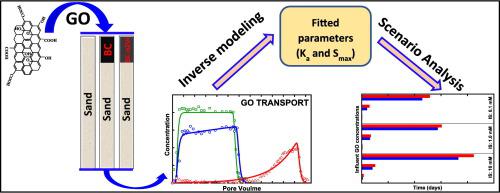Journal of Contaminant Hydrology ( IF 3.5 ) Pub Date : 2022-04-14 , DOI: 10.1016/j.jconhyd.2022.104014 Md Sazadul Hasan 1 , Jingnuo Dong 1 , Venkataramana Gadhamshetty 2 , Mengistu Geza 1

|
Experimental data from fixed-bed column studies and a numerical model based on convection-dispersion equations were used to describe transport and retention of Graphene Oxide (GO) in sand, biochar (BC), and BC modified with nanoscale zero-valent iron (BC-nZVI). Three blocking functions, namely no blocking, site-blocking, and depth-dependent blocking, were used to analyze GO transport and retention behavior in each media as a function of Ionic Strength (IS). An inverse modeling approach was implemented to determine the attachment coefficient (Ka) and maximum solid-phase retention capacity (Smax). The Langmuirian attachment model with site-blocking function effectively described experimental GO breakthrough curves (R2 ~ 0.70–0.99) compared to other models, indicating the importance of introducing a limit on the attachment capacity of the media. The Ka values for BC and BC-nZVI were significantly higher than sand, attributable to high porosity, roughness, and surface chemical properties. The models predicted an increasing trend in Ka (0.065 to 0.615 min−1) in BC with increasing IS (0.1 to 10 mM), while Ka values decreased (2.26 to 0.349 min−1) for BC-nZVI. A consistent increase in Smax was observed for both BC and BC-nZVI with increasing IS. Scenario analysis was conducted to further understand the effect of influent IS, GO concentration, and treatment depth. BC-nZVI exhibited a higher Ka and Smax and as a result, higher GO retention than BC at lower IS (0.1 and 1.0 mM). BC-nZVI had a relatively lower Ka (0.349 min−1) at 10 mM IS, however, it outperformed BC when GO retention capacities are compared over a longer period attributable to a higher Smax (6.47). Complete GO breakthrough occurred in a 5 cm media after 350 and 465 days for BC and BC-nZVI, respectively at 10 mM IS and influent concentration of 0.1 mg·L−1. GO breakthrough time increased with increasing treatment depth, however, the relation was non-linear.
中文翻译:

模拟氧化石墨烯在生物炭中的运输和保留
固定床柱研究的实验数据和基于对流扩散方程的数值模型用于描述氧化石墨烯 (GO) 在沙子、生物炭 (BC) 和纳米级零价铁 (BC) 改性的 BC 中的传输和保留-nZVI)。三种阻塞功能,即无阻塞、位点阻塞和深度依赖阻塞,用于分析 GO 在每种介质中的传输和保留行为作为离子强度 (IS) 的函数。采用逆向建模方法来确定附着系数 (K a ) 和最大固相保留容量 (S max )。具有位点阻塞功能的 Langmuirian 附着模型有效地描述了实验 GO 突破曲线 (R 2 ~ 0.70–0.99) 与其他模型相比,表明限制介质附着能力的重要性。BC 和 BC-nZVI的 K a值显着高于沙子,这归因于高孔隙率、粗糙度和表面化学性质。模型预测随着 IS 增加(0.1 到 10 mM),BC 中的 Ka(0.065 到 0.615 min -1 )呈增加趋势,而BC - nZVI的Ka 值下降(2.26 到 0.349 min -1)。随着 IS 的增加,观察到 BC 和 BC-nZVI的 S max一致增加。进行情景分析以进一步了解进水 IS、GO 浓度和处理深度的影响。BC-nZVI 表现出更高的 Ka和 S max,因此,在较低的 IS(0.1 和 1.0 mM)下,GO 保留率高于 BC。BC-nZVI 在 10 mM IS 下具有相对较低的 K a (0.349 min -1 ),然而,当由于较高的 S max (6.47)在较长时期内比较 GO 保留能力时,它的表现优于 BC 。对于 BC 和 BC-nZVI,分别在 10 mM IS 和 0.1 mg·L -1的流入浓度下,在 350 天和 465 天后,在 5 cm 培养基中发生完全 GO 突破。GO突破时间随着治疗深度的增加而增加,然而,这种关系是非线性的。











































 京公网安备 11010802027423号
京公网安备 11010802027423号